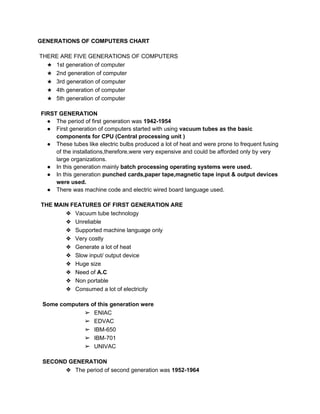
GENERATIONS OF COMPUTERS CHART
- 1. GENERATIONS OF COMPUTERS CHART THERE ARE FIVE GENERATIONS OF COMPUTERS ★ 1st generation of computer ★ 2nd generation of computer ★ 3rd generation of computer ★ 4th generation of computer ★ 5th generation of computer FIRST GENERATION ● The period of first generation was 1942-1954 ● First generation of computers started with using vacuum tubes as the basic components for CPU (Central processing unit ) ● These tubes like electric bulbs produced a lot of heat and were prone to frequent fusing of the installations,therefore,were very expensive and could be afforded only by very large organizations. ● In this generation mainly batch processing operating systems were used. ● In this generation punched cards,paper tape,magnetic tape input & output devices were used. ● There was machine code and electric wired board language used. THE MAIN FEATURES OF FIRST GENERATION ARE ❖ Vacuum tube technology ❖ Unreliable ❖ Supported machine language only ❖ Very costly ❖ Generate a lot of heat ❖ Slow input/ output device ❖ Huge size ❖ Need of A.C ❖ Non portable ❖ Consumed a lot of electricity Some computers of this generation were ➢ ENIAC ➢ EDVAC ➢ IBM-650 ➢ IBM-701 ➢ UNIVAC SECOND GENERATION ❖ The period of second generation was 1952-1964
- 2. ❖ This generation using the transistor was cheaper, consumed less power, more impact in size, more reliable and faster than the first generation. ❖ In this generation magnetic cores were used as primary memory and magnetic tape and magnetic disks as secondary storage devices. ❖ In this generation assembly language and high level programming languages like FORTRAN, COBOL Were used. ❖ There were batch processing and multiprogramming operating systems used. MAIN FEATURES OF SECOND GENERATION ❖ Use of transistors ❖ Reliable as compared to first generation computers ❖ Smaller size as compared to first generation computers ❖ Generate less heat consumed less electricity ❖ Faster than first generation computers ❖ Still very costly ❖ A.C needed ❖ Support machine and assembly language Some computers of this generation were ➢ IBM 1620 ➢ IBM 7094 ➢ CDC 1604 ➢ CDC 3600 ➢ UNIVAC 1108 THIRD GENERATION ★ The period of third generation was 1964-1972 ★ The third generation of computers is marked by the use of integrated circuits (IC’s) in place of transistors, resistors and capacitors along with the associated circuitry. ★ The i.c was invented by Jack kilby. ★ This development made computers smaller in size, reliable and efficient. ★ In this generation remote processing, time-sharpening, real-time, multiprogramming operating systems were used. ★ High level languages (FORTRAN-II to IV,COBOL,PASCAL PL/I, BASIC, ALGOL-68 etc..) were used during this generation. MAIN FEATURES OF THIRD GENERATION ARE ❖ IC used ❖ More reliable ❖ Smaller size
- 3. ❖ Generate less heat ❖ Faster ❖ Lesser maintenance ❖ Still costly ❖ A.C needed ❖ Consumed lesser electricity ❖ Support high level language Some computers of this generation are ➢ IBM-360 series,honeywell-6000 series ➢ PDP(personal data processor),IBM-370/168,TDC-316 FOURTH GENERATION ❖ The period of fourth generation was 1972-1990 ❖ The fourth generation of computers is marked by the use of very large scale integrated(VLS) circuits ❖ VLSI circuits having about 5000 transistors and other circuit elements and their associated circuits on a single chip made it possible to have microcomputers of fourth generation. ❖ In this generation time sharing, real time, networks, distributed operating system were used ❖ All the higher level languages like C and C++,DBASE etc..were used MAIN FEATURES OF FOURTH GENERATION ARE ➢ VLSI technology used ➢ Use of PC’s ➢ Very small size ➢ Pipeline processing ➢ no A.C needed ➢ Concept of the internet was introduced Some computers of this generation were ➢ DEC 10,STAR 1000,PDP 11 ,CRAY-I(supercomputer) ➢ CRAY-X-MP(supercomputer) FIFTH GENERATION ❖ The period of fifth generation is 1990-till date ❖ In this generation the VLSI technology became ULSI (ultra large scale integration ) technology
- 4. ❖ This generation is based on parallel processing hardware and AI (artificial intelligence) software ❖ All the higher level languages like C and C++, java,net etc .are used ❖ Robotics, neural networks, game playing,development of expert systems to make decisions in real life situations MAIN FEATURES OF FIFTH GENERATION ARE ❖ ULSI technology ❖ Development of natural language processing ❖ Advancement in superconductor technology ❖ More user friendly interfaces with multimedia features Some computers of this generation were ➢ Desktop ➢ Laptop ➢ Notebook ➢ Ultrabook